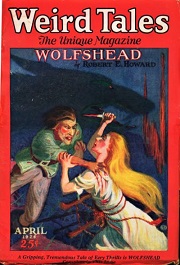
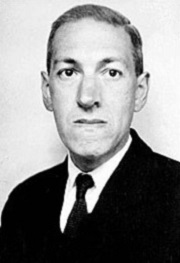 The Black Mass (1963-65) aired “The Outsider” in October of 1965. The Black Mass was an odd duck radio program for two reasons. First, because it came just after what OTR historians, in retrospect, called the end of the Golden Age of Radio with the death of Suspense in September of 1962, one of the longest running (1942-62), well produced, and classiest shows in all of radio. Second, because it was not made for a commercial network but was produced out of Berkley, CA’s KPFA radio station and the Pacifica Network, the first listener supported radio station in the country (the forerunner of today’s partially government supported PBS stations). Not constrained by commercial or advertising considerations it could offer more “artistic” programming, if you will. Jack Nessel, Drama & Literature Director at KPFA, suggested the show to Erik Bauersfeld, a professor of aesthetics and philosophy at the California School of Fine Arts. Skeptical at first, Bauersfeld came around and would take classic horror stories by the likes of Lord Dunsany, Ambrose Bierce, Edgar Allan Poe, H. P. Lovecraft, and others, and adapt them in dramatic fashion for radio, also assuming the lead role in the shows. Given the relatively old-fashioned (certainly by today’s standards) studio equipment and modest financial resources, The Black Mass exhibits high quality in every aspect: sound/special effects/music score, dialog, acting, and overall creepiness.
The Black Mass (1963-65) aired “The Outsider” in October of 1965. The Black Mass was an odd duck radio program for two reasons. First, because it came just after what OTR historians, in retrospect, called the end of the Golden Age of Radio with the death of Suspense in September of 1962, one of the longest running (1942-62), well produced, and classiest shows in all of radio. Second, because it was not made for a commercial network but was produced out of Berkley, CA’s KPFA radio station and the Pacifica Network, the first listener supported radio station in the country (the forerunner of today’s partially government supported PBS stations). Not constrained by commercial or advertising considerations it could offer more “artistic” programming, if you will. Jack Nessel, Drama & Literature Director at KPFA, suggested the show to Erik Bauersfeld, a professor of aesthetics and philosophy at the California School of Fine Arts. Skeptical at first, Bauersfeld came around and would take classic horror stories by the likes of Lord Dunsany, Ambrose Bierce, Edgar Allan Poe, H. P. Lovecraft, and others, and adapt them in dramatic fashion for radio, also assuming the lead role in the shows. Given the relatively old-fashioned (certainly by today’s standards) studio equipment and modest financial resources, The Black Mass exhibits high quality in every aspect: sound/special effects/music score, dialog, acting, and overall creepiness.
It is not known how many shows were made due to the fact that they were produced and aired on no set schedule after the first bunch was completed, and estimates run from 43 to 47 and some to as many as 59 if you include rebroadcasts into the 1970s. Another marked difference from a program produced for commercial networks is that the length of these shows varied from 3 to just over 40 minutes, though most were in the 25-30 minute range.
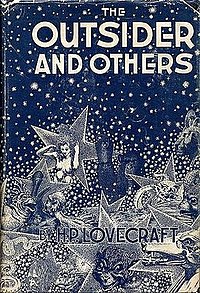 “The Outsider” first saw print in the April 1926 issue of Weird Tales (1923-54), though HPL (1890-1937) wrote it over a period of months five years earlier in 1921. It was reprinted for the first time by Arkham House in 1939 under the title The Outsider and Others (cover at right). One of Lovecraft’s most popular and oft-reprinted stories it has subsequently been included in numerous HPL collections over the years. Told in first person, the story relates the sad plight of a man divorced from all human contact who lives in a castle surrounded by a thick forest of tall trees. He has never been exposed to natural sunlight, has never seen another human being, and has lived his life in his castle-prison. I dare not say more, except to set the mood by revealing that the man eventually uncovers a corpse and is so lonely that…. Well, just read the following description, and if this doesn’t whet your whistle in anticipation of listening to the entire story (if your lips haven’t gone dry due to the utter horror), then nothing will.
“The Outsider” first saw print in the April 1926 issue of Weird Tales (1923-54), though HPL (1890-1937) wrote it over a period of months five years earlier in 1921. It was reprinted for the first time by Arkham House in 1939 under the title The Outsider and Others (cover at right). One of Lovecraft’s most popular and oft-reprinted stories it has subsequently been included in numerous HPL collections over the years. Told in first person, the story relates the sad plight of a man divorced from all human contact who lives in a castle surrounded by a thick forest of tall trees. He has never been exposed to natural sunlight, has never seen another human being, and has lived his life in his castle-prison. I dare not say more, except to set the mood by revealing that the man eventually uncovers a corpse and is so lonely that…. Well, just read the following description, and if this doesn’t whet your whistle in anticipation of listening to the entire story (if your lips haven’t gone dry due to the utter horror), then nothing will.
“My first conception of a living person was of something distorted… shrivelled… decaying. I remember there was such a corpse. I often went to it with a feeling of reverence and attachment. It was a woman… ancient… lying as she had died, partly eaten around the throat and chest… the terrible gesture of horror in her sprawled position and opened mouth. I would sometimes roam the passage where she lay. I seem to be drawn there. I wanted to kneel before it. To lie my head against it.”
Play Time: 22:24
{October of 1965 saw the now teenaged neighborhood gang still finding time from sports and school to make it to the corner drugstore to continue their lifelong passion for the SF/F magazines (though the pulps were now gone). The last issue of Astounding (at least with that name on the cover) came in September of 1960; henceforth it would be known as Analog (with minor variation in the suffix). Oe thing that did not change with the updated cover name was the solid monthly schedule. Worlds of IF (1952-86) was the younger companion magazine to Galaxy, which magazine saw its first issue in October of 1950. With fare like the now famous cover story below and Frederik Pohl as editor (along with Galaxy since 1960 when editor H. L. Gold was injured in a car accident) it is no wonder that IF won the Hugo Award as Best Magazine three years running–1966, 1967, and 1968. The Magazine of Fantasy and Science Fiction (Fall 1949 to present) had found its audience and was winning more readers with every issue. A long-running monthly by 1965, it celebrated its 16th Anniversary Issue with their special October issue, an annual event begun in 1958 and now much anticipated by its fans.}
[Left: Analog, October 1965 – Center: IF, October 1965 – Right: F&SF, October 1965]
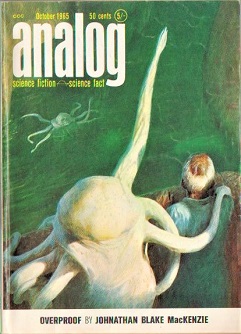
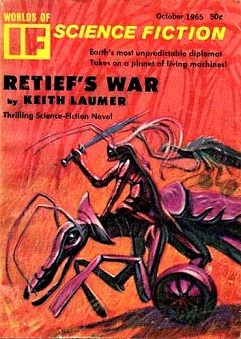
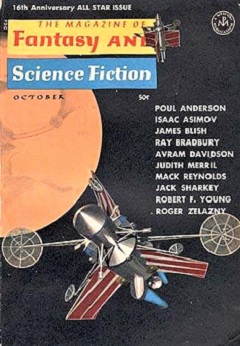
To view the entire list of weekly Old Time Radio episodes at Tangent Online, click here.